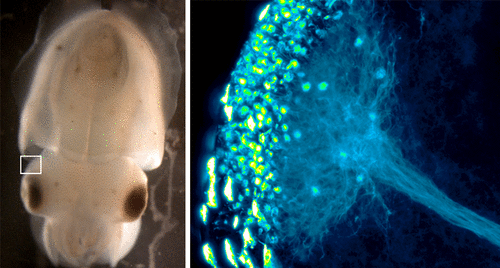当前位置:
X-MOL 学术
›
ACS Chem. Neurosci.
›
论文详情
Our official English website, www.x-mol.net, welcomes your feedback! (Note: you will need to create a separate account there.)
Immunohistochemical Approach to Understanding the Organization of the Olfactory System in the Cuttlefish, Sepia officinalis
ACS Chemical Neuroscience ( IF 5 ) Pub Date : 2018-03-26 00:00:00 , DOI: 10.1021/acschemneuro.8b00021 Alexia T. Scaros 1 , Roger P. Croll 1 , Sébastien Baratte 2
ACS Chemical Neuroscience ( IF 5 ) Pub Date : 2018-03-26 00:00:00 , DOI: 10.1021/acschemneuro.8b00021 Alexia T. Scaros 1 , Roger P. Croll 1 , Sébastien Baratte 2
Affiliation

|
Cephalopods are nontraditional but captivating models of invertebrate neurobiology, particularly in evolutionary comparisons. Cephalopod olfactory systems have striking similarities and fundamental differences with vertebrates, arthropods, and gastropods, raising questions about the ancestral origins of those systems. We describe here the organization and development of the olfactory system of the common cuttlefish, Sepia officinalis, using immunohistochemistry and in situ hybridization. FMRFamide and/or related peptides and histamine are putative neurotransmitters in olfactory sensory neurons. Other neurotransmitters, including serotonin and APGWamide within the olfactory and other brain lobes, suggest efferent control of olfactory input and/or roles in the processing of olfactory information. The distributions of neurotransmitters, along with staining patterns of phalloidin, anti-acetylated α-tubulin, and a synaptotagmin riboprobe, help to clarify the structure of the olfactory lobe. We discuss a key difference, the lack of identifiable olfactory glomeruli, in cuttlefish in comparison to other models, and suggest its implications for the evolution of olfaction.
中文翻译:

免疫组织化学方法,以了解墨鱼,乌贼墨中的嗅觉系统的组织。
头足类动物是非传统的但无脊椎动物神经生物学的迷人模型,尤其是在进化比较中。头足类嗅觉系统与脊椎动物,节肢动物和腹足类动物有着惊人的相似性和根本性差异,这引发了人们对这些系统的祖先起源的质疑。我们在这里描述普通乌贼乌贼味的嗅觉系统的组织和发育,使用免疫组织化学和原位杂交。FMRFamide和/或相关肽和组胺是嗅觉感觉神经元中假定的神经递质。其他神经递质,包括嗅觉和其他脑叶内的5-羟色胺和APGWamide,提示嗅觉输入的传出控制和/或嗅觉信息处理中的作用。神经递质的分布,以及鬼笔环肽,抗乙酰化的α-微管蛋白和突触突触核蛋白核糖蛋白的染色模式,有助于阐明嗅觉叶的结构。与其他模型相比,我们讨论了墨鱼中的关键区别,即缺乏可识别的嗅觉肾小球,并提出了其对嗅觉演变的影响。
更新日期:2018-03-26
中文翻译:

免疫组织化学方法,以了解墨鱼,乌贼墨中的嗅觉系统的组织。
头足类动物是非传统的但无脊椎动物神经生物学的迷人模型,尤其是在进化比较中。头足类嗅觉系统与脊椎动物,节肢动物和腹足类动物有着惊人的相似性和根本性差异,这引发了人们对这些系统的祖先起源的质疑。我们在这里描述普通乌贼乌贼味的嗅觉系统的组织和发育,使用免疫组织化学和原位杂交。FMRFamide和/或相关肽和组胺是嗅觉感觉神经元中假定的神经递质。其他神经递质,包括嗅觉和其他脑叶内的5-羟色胺和APGWamide,提示嗅觉输入的传出控制和/或嗅觉信息处理中的作用。神经递质的分布,以及鬼笔环肽,抗乙酰化的α-微管蛋白和突触突触核蛋白核糖蛋白的染色模式,有助于阐明嗅觉叶的结构。与其他模型相比,我们讨论了墨鱼中的关键区别,即缺乏可识别的嗅觉肾小球,并提出了其对嗅觉演变的影响。



























 京公网安备 11010802027423号
京公网安备 11010802027423号